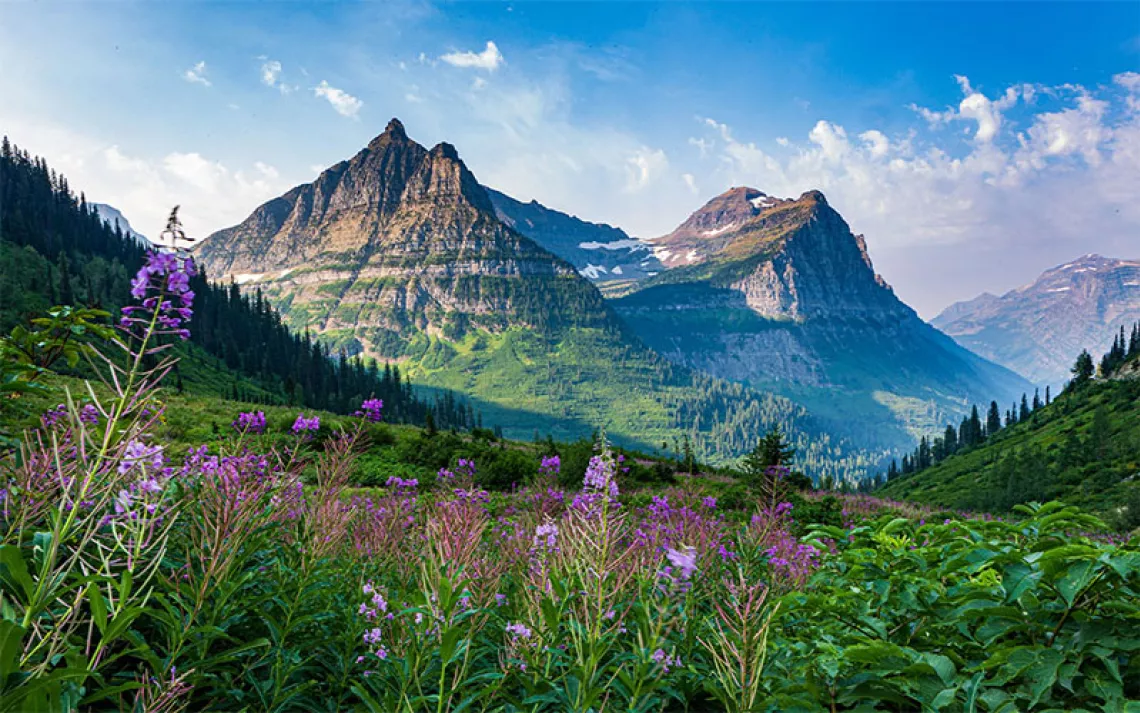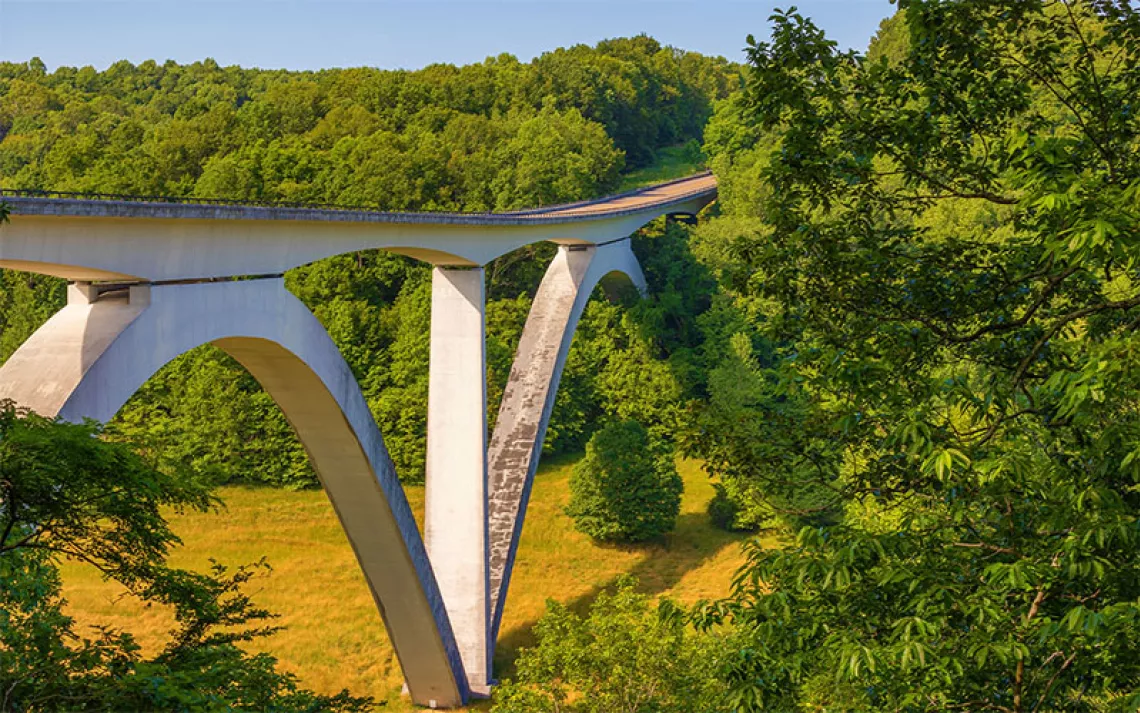What will climate change do to America's first national park?
One day parts of Yellowstone may look like Las Vegas
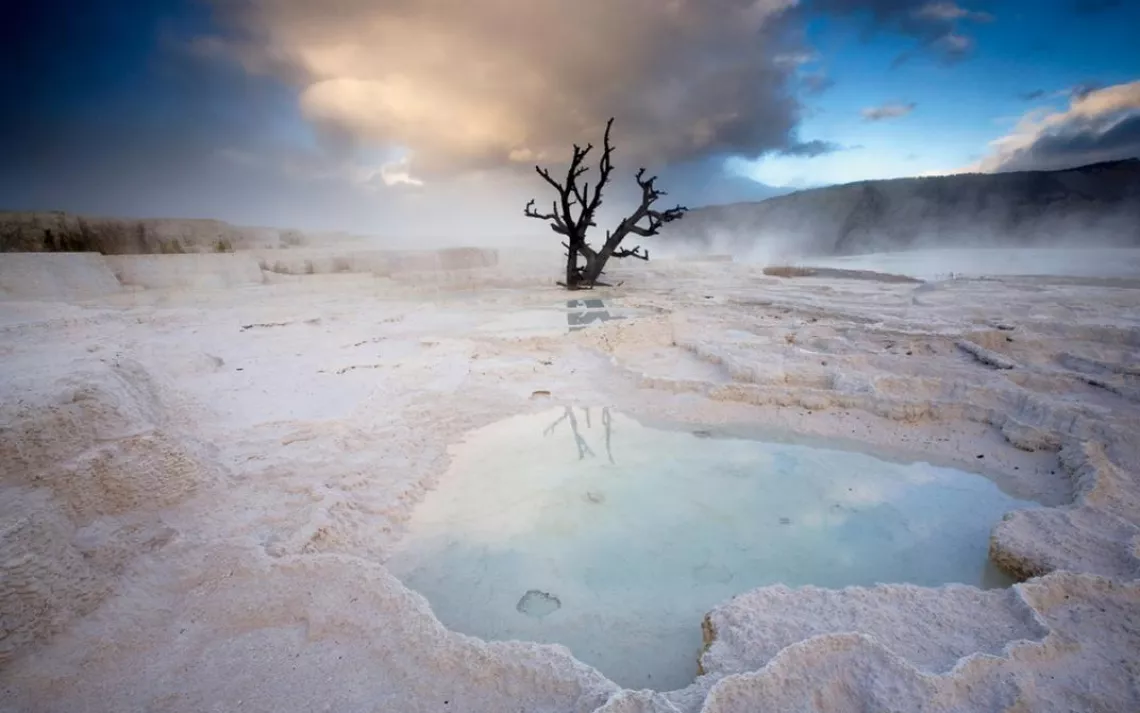
The unearthly Mammoth Hot Springs in Yellowstone National Park. | Photos by Ian Shive
Before dawn one icy morning in February, Ashea Mills and Mike Tercek met me in the lobby of the Mammoth Hot Springs Hotel. They had come from their home in Gardiner, Montana, just a few miles away, outside the north entrance of Yellowstone National Park. Despite the early hour, the lobby was busy. Groups of people in shiny winter coats, coffees clutched between two palms, waited for wildlife tours to take them to the Lamar Valley, where they hoped to spot elk, coyotes, or, ideally, a wolf pack. Tercek, Mills, and I had something else in mind—we wanted to observe the vegetation in the northern part of the park, which, according to climate predictions, will change dramatically as the climate warms over the next hundred years. But we, too, hoped to see a wolf pack along the way.
We hopped into an old station wagon and headed toward the Lamar Valley—which is arguably the premier wildlife-watching area in the United States outside of Alaska—and Mills tuned in to a limited-access radio frequency used by wolf watchers. After two decades spent living and guiding in Yellowstone, Mills had enough local clout to be granted access. "People follow the wolves religiously," she told me. "They know who's been killed, who's injured. They root for different packs." Somewhere down in the valley, people were talking into their radios, sending the occasional crackly voice into our car. We listened with the rest of the wolf watchers, hoping someone would spot a pack and tell us where to pull over.
As Mills focused on the walkie-talkie, I watched the arid landscape roll by out the window. Brittle-looking juniper and sagebrush sprouted from the snowy ground. Compared with the verdant forest that blankets 80 percent of Yellowstone, it was an uninviting scene.
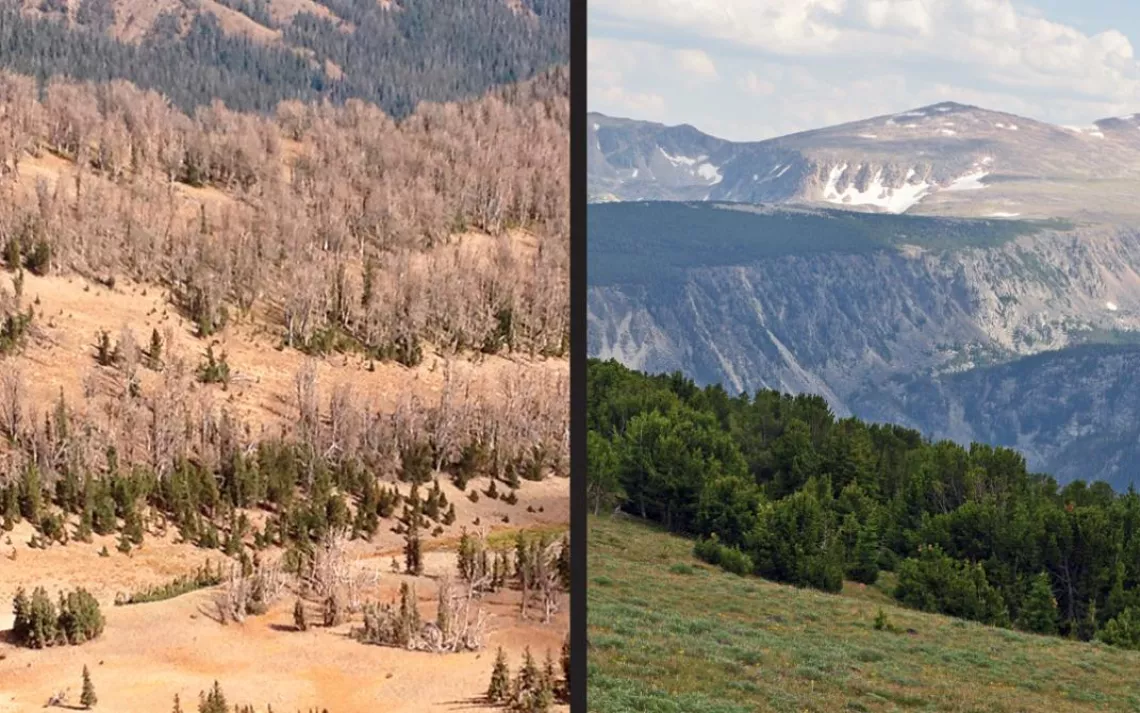
Left: A whitebark pine forest destroyed by beetles. Right: A healthy stand of whitebark pine. | Photos by Jesse Logan
"This is sagebrush steppe that we're in right now," said Tercek, an ecologist who analyzes climate data for Yellowstone and other national parks. "It's characteristic of the lower elevations of the Gardiner Basin and up in the valleys. As you get farther up, you get more trees. At lower elevations, it's Douglas fir. Higher up, you get Engelmann spruce and subalpine fir."
Yellowstone, like the rest of the world, is warming. One of the ecological consequences is that this entire vegetation palette could migrate upward, to cooler climes. Projections show sagebrush and juniper habitat expanding uphill by 30 to 55 percent, while habitat for high-elevation trees like lodgepole pine, Engelmann spruce, and subalpine fir could decline by 50 to 85 percent. Much of the park would look like the sagebrush landscape we were driving through. "I've heard people say that Gardiner could have a climate like Las Vegas," Tercek said.
The Lamar Valley ridges were smoothed out by snow, rolling subtly out to distant mountains. We passed bison seated on knolls and saw the walking paths they had made by heaving their heads from side to side through the snow drifts. A family of bighorn sheep were perched on the hillside, like hawks. We pulled over to peer into a gulch and watch a coyote gnawing on a carcass. Despite a small crowd of spectators, the animal went about its business seemingly unconcerned.
A voice came over the radio. "Sounds like we've got something up here. It's pretty close," Mills said. We popped over a small hill and saw several vehicles parked at a pullout. A dozen people were lined up behind them, staring across the road through spotting scopes. There were wolves on the hillside. One appeared to be either black or very dark red. Another was gray. Even through high-powered optics, they were so far away that their fur looked grainy, and their movements were almost imperceptible, but people still gazed into their viewfinders, transfixed by these symbols of the wilderness. Only two decades after wolves were reintroduced into the park, it's hard to imagine Yellowstone without them.
We left the wolf watchers behind and headed for the park's northeast corner, which is colder and higher than the Lamar Valley and lies at the southern edge of the Beartooth Mountains. Whereas the Lamar had been sparsely forested and busy with people, the lower slopes of the Beartooths were thick with old trees, and the road was all but empty.
At the Warm Creek Trail, we pulled off and skied into the forest. There was snow everywhere. The trees were tall and broad. After two hours of driving and five minutes of skiing, we had reached what felt like another park altogether—lush, shadowy, and very cold. A few miles in, we stopped to eat beef jerky and marvel at the old-growth trees around us. I asked Tercek what he thought this forest would look like in 2100. He said that it may not exist.
Last year, the journal Yellowstone Science devoted an entire issue to examining how climate change would affect the Greater Yellowstone Ecosystem, a collection of national forests and wilderness areas surrounding Yellowstone National Park that, according to the National Park Service, is "one of the largest nearly intact temperate-zone ecosystems on Earth." In the editor's note, Ann Rodman asked, "Can you imagine Yellowstone without most of the forest that now covers 80 percent of the park?"
Through a series of articles, the journal pieced together a picture of what may happen as the climate continues to warm. One article was titled "Ecological Implications of Climate Change in Yellowstone: Moving Into Uncharted Territory?" The authors, ecologists Monica Turner and William H. Romme,had ventured to discuss climate change in Yellowstone in an earlier article, written in 1992. The "changes are coming much sooner than previously thought; many are already underway," they wrote in 2015. "It is also apparent that the ecological effects of climate change will be more dramatic and far-reaching than we realized [in 1992]." They described the vegetation's predicted upward shift, and they wrote that the conditions for large forest fires—like the ones that burned over 30 percent of the park in 1988—could become normal. "The fires that occur in Yellowstone typically happen when you have hot, dry, windy summers," Turner told me. "We consider them to be limited by climate conditions. In other words, there's plenty of fuel to burn, but usually you don't have the climate conditions for burning to occur. What would happen if the climate got really hot and dry almost every summer?"
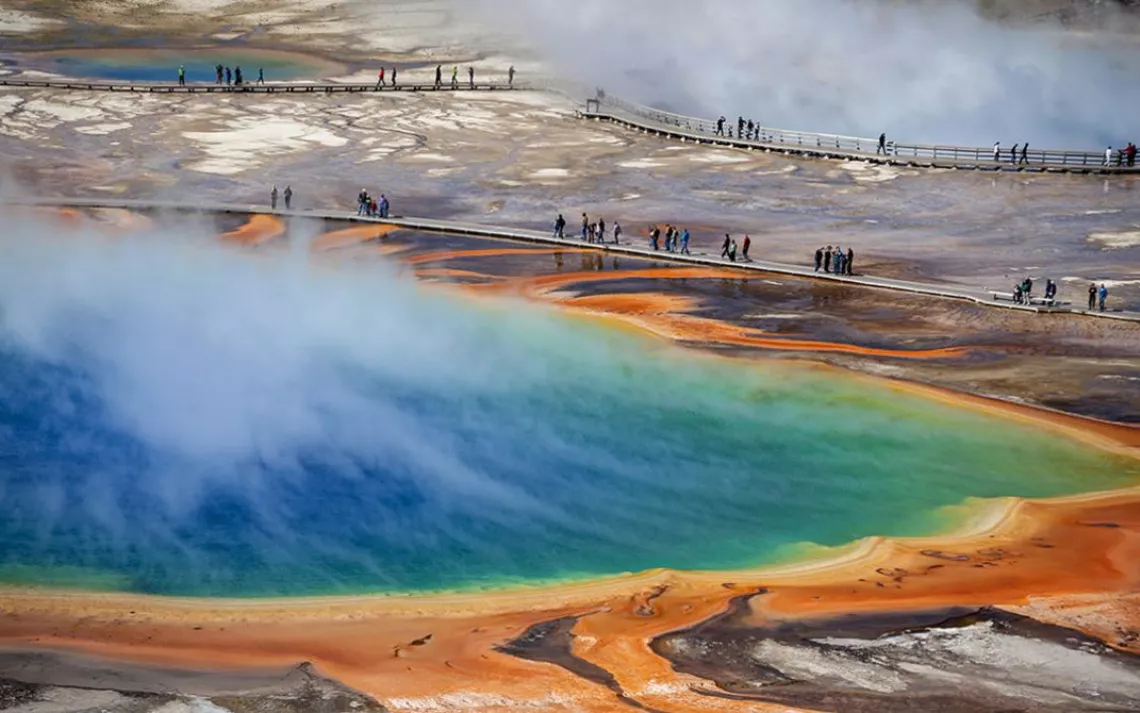
Summer visitors to Yellowstone National Park's Grand Prismatic Spring. | Photo by Ian Shive
In another article, Tony Chang and Andrew Hansen, ecologists at Montana State University, modeled the future climate in the Greater Yellowstone Ecosystem. "By 2100, temperature is projected to increase 6° to 13°F above the average for the reference period of 1900-2010," they wrote. "One possible future is for the system to move into a new state with little summer snow, very low stream flows, and frequent and severe fire, and to switch from forest-dominated vegetation to desert scrub vegetation." Tercek wrote of how Yellowstone's snowpack is already in decline, and melting earlier and earlier, which will affect agriculture in the valleys downstream of Yellowstone. Chang and Hansen stated that in the year 2075, much of the park could be snow-free by April 1.
It's not clear how these changes will affect the park's wildlife. But species such as the cutthroat trout and the American pika are already stressed by warming streams and snow loss, respectively. The wolverine is another species that needs snow. Grizzly bears, red squirrels, and Clark's nutcrackers all eat the nuts of the whitebark pine, a high-elevation tree that could be pushed off the map by less snow and higher temperatures.
Despite the dramatic nature of the projected changes, Romme's perspective is that Yellowstone won't disappear; it will just be different. "Even though the Greater Yellowstone Ecosystem is likely to change, we don't think it will be destroyed. It will still be beautiful. It will still be of great value to science," he told me.
But Hansen, who lives in Bozeman, Montana, is more concerned about Yellowstone's transformation. "When you add the projected change in fire regime and the projections on invasive species and human land development and backcountry recreation . . . it's a pretty mind-bendingly different world, what this place could look like in 2100."
Plants could establish uphill of their current ranges only after today's dominant vegetation dies and makes room for new species to move in. The transition from forest to nonforest would be precipitated by what scientists call "disturbances," events like fire or beetle infestation that kill off large numbers of trees, making way for new climate-suitable vegetation to pop up in their place. This type of change might already be happening with whitebark pine forests.
"Whitebark pine is a kind of first responder species to climate change," Chang told me. Warmer, drier weather has allowed parasitic mountain pine beetle populations to explode. Some experts estimate that about 75 percent of cone-bearing whitebark pine trees in the Greater Yellowstone Ecosystem have died in the past 30 years, caused by the 1988 fires, pine beetle attacks, and a fungus called white pine blister rust. "If you're interested in climate change in Yellowstone," Chang said, "this tree is one of the best species to look at."
The day after riding around the northern tier of the park with Tercek and Mills, I met up with Chang at a cafe in Bozeman. We drove south, along a road that hugged a pearlescent Gallatin River. Our destination was Beehive Basin, a backcountry skiing area in the Spanish Peaks. "I'm curious to see the status of the whitebark pine in this area," Chang said in the car. "But the more interesting thing is to see what's growing up underneath." Today, whitebark pine inhabits the high edge of the forest, bound below by competitors and above by sheer rock. As the ecosystem's highest-elevation tree species, it could be at risk of being pushed into rocky alpine areas, or, where the peaks are lower, out of existence. Chang had suggested that we visit the area after I told him I wanted to see what climate change had already done—and would do in the future—to the Yellowstone landscape.
We clipped into skis and trudged over sticky, warm snow into the basin. Behind us, gray clouds bulged above pyramid peaks, promising some form of precipitation. I moved slowly while Chang, a rangy mountaineer in his early 30s, sped ahead. He seemed naturally fit, despite the fact that he spends most of his time in front of a computer. He once lived in the wilderness near Yosemite, maintaining trails, then became a hotshot firefighter who got yelled at for asking too many questions. He decided to study ecology, in part, because he wanted to understand the logic behind controlled burning of healthy forests.
As we gained elevation, the ridgelines came into view. They were covered in a skeleton forest of whitebark pine, most of it gray and bare, or red-needled, and all of it in some stage of slow death. The trees had been ravaged by beetles and probably by blister rust, too.
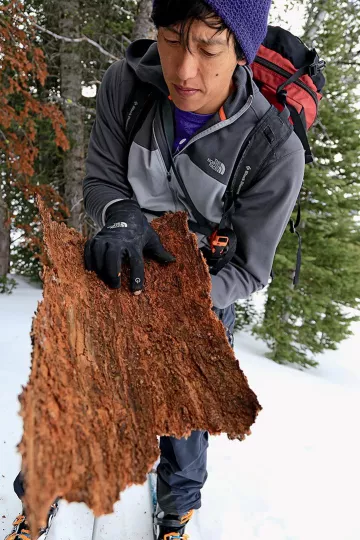
Ecologist Tony Chang examines a piece of whitebark pine for blister rust and beetle damage in the Greater Yellowstone Ecosystem. | Photo by Jake Abrahamson
"Look at how it's oozing," Chang said, getting close to one tree. "It's trying to get rid of the blister rust." The trees' branches hung limp and ragged. "Does this forest look healthy to you?" he asked. "Maybe not, but these guys that are still standing"—he gestured at a few healthy trees nearby—"are gonna be psyched. They're mostly subalpine fir and spruce." We were seeing, it seemed, a snapshot of the transition from a whitebark pine forest to a subalpine fir and spruce forest, aided by the disturbance of the mountain pine beetles. Chang skied over and looked at some saplings. "This area has typically been dominated by whitebark pines. They could be up to 500 years old. But in 100 years, it will be dominated by these baby spruce trees."
We skied farther, into a clearing, and could see all the way up the valley, to where the Spanish Peaks struck the sky. Chang pointed to a cirque below the peaks and said, "That area might be where future intact whitebark forest is."
Chang has identified all of the places in the Greater Yellowstone Ecosystem where whitebark pine will be able to live in the future, given where scientists believe the climate is headed. He is also in the process of creating a similar map for mountain pine beetle habitat. If land managers decide to assist the whitebark pine's recovery, Chang's maps could help them decide where to plant new trees.
But a significant portion of the suitable habitat is in wilderness areas, and this raises a difficult question for land managers and conservationists: What would it mean to plant trees in places we have set aside to be free of human intervention? The question is complicated by the fact that the whitebark pine's path toward extirpation has been largely cleared by humans. Climate change has penetrated the legal boundaries we've created to protect parks and wildernesses from harmful human activities.
Yellowstone is not the only park that will be reshaped by climate change. A 2014 study by Hansen and others looked at climate projections for 57 national parks across the United States and found that 40 percent of the area within those parks will be unsuitable for current biomes by 2090. The landscapes we intend to preserve with our national parks could transform into something else before our eyes. In his 2010 book, Uncertain Path, William C. Tweed, a historian and retired park naturalist, uses a trek through the Sierra Nevada as an occasion to ponder how climate change might require us to reconsider what we want from our national parks. "Since the [National Park] Service's establishment in 1916," he writes, "it has promised two things—that the resources of the parks will be preserved 'unimpaired for the enjoyment of future generations,' and that the parks themselves will be available for public enjoyment. The mission defined by these phrases has evolved in many ways over the succeeding 90-plus years, but it has changed little over the decades as far as the public is concerned. . . . The promise to the public has always been that the national parks will be preserved intact."
Until climate change came into the picture, parks could be managed with a general expectation that, left to themselves, our treasured landscapes would persist in a certain predictable form. Look at Yellowstone: Many elk might die in a particularly cold winter, whitebark pines might be ravaged by beetles, and forest fires might burn large portions of the park. Despite these fluctuations in the ecosystem, though, we have always ended up with a landscape that we recognized as Yellowstone. We could let the place be "wild" and still have our scenery.
But in the era of climate change, we may not be able to expect such fidelity from our wild landscapes. As Tweed writes, "'Natural' processes cannot lead reliably to 'natural' results in a world where anthropogenic climate change, global pollution, and habitat fragmentation have changed the operating rules, and where society's very definition of nature is no longer clear."
Tweed recounts how after 250 miles of backpacking, he walked into the Giant Forest, a grove of sequoias that is home to 5 of the 10 largest trees on the planet, to find that many of the trees were stressed or dying. Barring any human intervention, the forest's long-term survival seemed to be in jeopardy, and with it, the "promise" that it would be preserved for generations to come. He floats the possibility of setting aside the Giant Forest as an "ecosystem museum" in which the forest would essentially be curated as a botanical garden. Park staff would weed out harmful invasive species and even irrigate the trees.
This is not as farfetched as it might sound: Turning our parks into ecosystem museums would at least ensure that future generations would continue to enjoy these landscapes as we have always known them. But there are drawbacks. Such micromanagement would assert that we value our parks first and foremost as scenic commodities while sacrificing the wildness that we want to exist there. If we choose the ecosystem museum, we give up on preserving wildness.
Aside from geysers, wildness may be what we value most about Yellowstone. It's what makes the wolves and bison and bears that roam the Lamar Valley different from their cousins that laze in zoo enclosures and are fed by humans. Would we want to curate grasslands for bison to graze? Would we supply wolves with carrion? Is there still wildness in a landscape that is so heavily shaped by anthropogenic forces? We may not be in danger of losing our charismatic megafauna tomorrow, but we need to consider these questions today. The answers we arrive at will determine the shape and character of the "new" Yellowstone, the one that the Park Service will steward in the century to come.
 The Magazine of The Sierra Club
The Magazine of The Sierra Club
